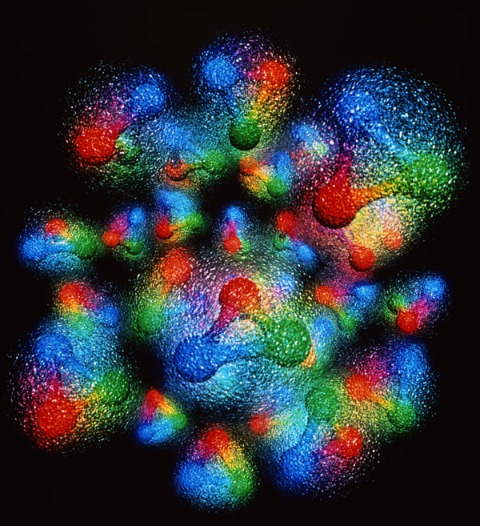Jul. 20, 2023 Research Highlight Physics / Astronomy
Probing the properties of vacuum in nuclei
The effect of high densities on the properties of vacuum have been quantitatively deduced for the first time
By creating special atoms, RIKEN physicists have measured how the extremely high density of atomic nuclei influences the properties of vacuum1. This could help to shed light on where matter gets most of its mass.
As its name implies, the strong force is the strongest of the four fundamental forces, being about 100 times stronger than the electromagnetic force, the second strongest force. It is so strong that it causes pairs of quarks—the building blocks of protons and neutrons—and antiquarks (the antiparticles of quarks) to spontaneously form in vacuum.
While these quark–antiquark pairs are not directly observable, they alter the properties of vacuum and can be detected through their effects on other processes. In particular, they break the symmetry of vacuum.
This symmetry breaking of vacuum has surprising effects. Both protons and neutrons are made up of three quarks, but the masses of the quarks only account for about 1% of the total mass of a proton or neutron. A significant proportion of the remainder of their mass is thought to come from the symmetry breaking of vacuum.
Increasing either the temperature or the density of matter present is theoretically predicted to partially restore the symmetry of vacuum. While several experiments have verified this effect at high temperatures, none have been done at high matter densities.
Now, Kenta Itahashi of the RIKEN Nishina Center and co-workers have measured with high precision the partial restoration of vacuum symmetry at high densities, obtaining excellent agreement with theory.

Figure 1: A depiction of an atomic nucleus, showing protons and neutrons, which are composed of three quarks held together by the strong force. RIKEN researchers have measured the effect of the nucleus’ high density on the symmetry of vacuum. © ARSCIMED/SCIENCE PHOTO LIBRARY
They did this by creating special atoms of the metal tin using the RIKEN Radioactive Isotope Beam Factory, a facility that creates beams of heavy ions by accelerating them in stages. Instead of having electrons circling the nucleus, these atoms had a pion—an extremely short-lived particle consisting of a quark and antiquark. Unlike electrons, which only experience the electromagnetic force, pions interact with the nucleus through both the strong and electromagnetic forces. Since a nucleus is about 100 trillion times denser than normal matter, this enabled the researchers to probe the effect of high density on the symmetry of vacuum.
The experiment itself only took ten days, but the subsequent analysis of the results took about nearly ten years to complete. The initial results overlapped only slightly with those predicted by theory, but after correcting various effects and updating parameters as more accurate ones became available, the results agreed very well with theory.
“We were surprised at the consistency between the achieved result and the fundamental theories,” says Itahashi. “Thanks to the continuous efforts of our collaborators, we were able to achieve unprecedented accuracy.”
Related content
- Machine learning algorithms could offer a glimpse into the heart of the proton
- In a neutron-rich tin nucleus, electromagnetism can win over the strong force
Rate this article
Reference
- 1. Nishi, T., Itahashi, K., Ahn, D., Berg, G. P. A., Dozono, M., Etoh, D., Fujioka, H., Fukuda, N., Fukunishi, N., Geissel, H. et al. Chiral symmetry restoration at high matter density observed in pionic atoms. Nature Physics 19, 788–793 (2023). doi: 10.1038/s41567-023-02001-x
